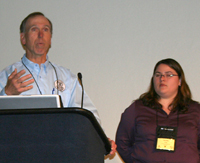Technical Keynote Session 2
Improving EPD Accuracy Through On-Ranch Evaluation
Expected progeny differences (EPDs) are valuable selection tools, but they can sometimes be limited by lower accuracy. Calculating on-ranch EPDs (rEPDs) can improve those accuracies, according to Daniel Drake, professor at the University of California-Davis, who spoke at the 2009 Beef Improvement Federation (BIF) symposium May 1 in Sacramento, Calif.

Daniel Drake (left) and Kristina Weber, University of California-Davis
Along with Kristina Weber and Alison Van Eenennaam, Drake analyzed data from three calving seasons, including 300 spring steer calves and 500 fall steer calves, to calculate rEPDs for 30 Angus herd bulls, including carcass weight, backfat, ribeye area and marbling. The rEPDs were then compared to those calculated on the bulls by the American Angus Association.
For natural-service bulls with American Angus Association-calculated EPD accuracy of ≤0.15, the average improvement in rEPD accuracy was 0.21 for carcass weight, 0.17 for backfat, 0.20 for marbling and 0.17 for ribeye area. Accuracies for bulls with higher accuracies were not substantially improved.
“Correlations between American Angus Association-calculated EPDs and rEPDs derived from multi-season data for bulls with nine or more phenotyped steer progeny were stronger for ribeye area and marbling than for backfat thickness and carcass weight,” Drake said. “Correlation for rEPDs from season-to-season was consistent and moderate for ribeye area and carcass weight, but inconsistent for fat thickness and marbling.”
Improving accuracy by calculating these rEPDs would be most valuable for younger sires since they have a longer time remaining to influence the herd, Drake said. However, this is a challenge since younger sires typically produce far fewer progeny than older sires, so there is not enough data. The ranch used in the study was able to successfully increase the number of progeny sired by its younger bulls by segregating them by age in the multi-sire pastures.
The study then simulated genetic selection based on single-season marbling rEPDs and corresponding phenotype changes of progeny in the next season. However, the marbling rEPD failed to accurately predict the changes observed in the simulation. The same was true for simulated selections based on American Angus Association-calculated marbling EPDs.
“Carcass traits are ideally suited to a DNA-based approach that provides increased accuracy of genetic estimates at a young age,” Drake concluded.
Editor’s Note:This summary was written under contract or by staff of Angus Productions Inc. (API). To request reprint rights contact Shauna Rose Hermel, editor, at 816-383-5270. PowerPoints are posted with permission of the presenter and may not be reproduced in whole or in part without the express permission of the presenter.
The 41st BIF Research Symposium and Annual Meeting was hosted by the California Beef Cattle Improvement Association and the California Cattlemen's Association. For more information, visit www.bifconference.com or www.calcattlemen.org/bif2009.html.



